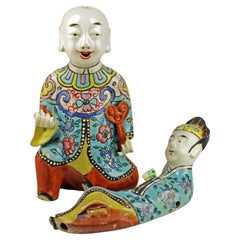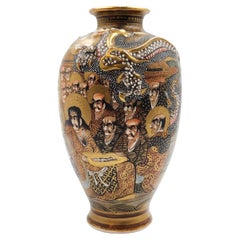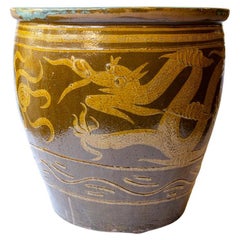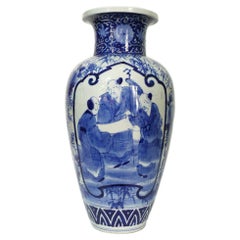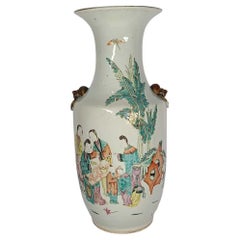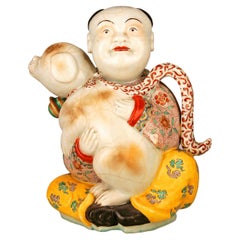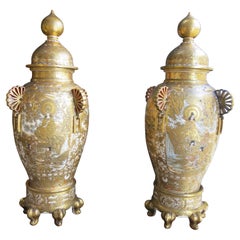Argentina - Ceramics
to
2
1,986
1,348
12
5
7
5
2
4
2
11
5
4
3
2
11
11
9
2
1
12
12
12
2
Item Ships From: Argentina
Pair of Mid-19th Century/Qing Dinasty of Enameled Chinese Porcelain Figurines
Located in North Miami, FL
Pair of Mid-19th century/Qing dinasty enameled chinese porcelain figurines depicting a laughing boy kneeling and another lying down
By: unknown
Material...
Category
Mid-19th Century Chinese Qing Antique Argentina - Ceramics
Materials
Enamel
Satsuma Imperial Vase "A Thousand Faces" Meiji Period
By Satsuma
Located in Autonomous City Buenos Aires, CABA
Satsuma Imperial Vase "A Thousand Faces" Meiji Period
A Japanese collectible vase, hand painted decorated with intricate designs and figures, with a classic shape and painted with va...
Category
19th Century Japanese Meiji Antique Argentina - Ceramics
Materials
Ceramic
Antique circa 1900 Chinese Very Large Earthenware Dragon Planter Plant Egg Pot
By Satsuma
Located in Autonomous City Buenos Aires, CABA
Antique Chinese glazed ceramic egg cup. This brown glazed stoneware urn displays vibrant turquoise tones within. Large egg planter currently being used as ...
Category
Early 1900s Chinese Chinese Export Antique Argentina - Ceramics
Materials
Earthenware
Chinese Qing Dynasty Vase
Located in Buenos Aires, Argentina
Chinese Qing Dynasty Vase
Circa 1900 Origin China
Decoration with traditional scenes
(1644 - 1911)
Glazed and enamelled technique
Blue and white colour
Po...
Category
Early 1900s Chinese Chinese Export Antique Argentina - Ceramics
Materials
Enamel
Chinese vase
Located in Buenos Aires, Argentina
Chinese vase
Famille Rose
Pink, green, and ochre colors.
It has a pair of handles with gold and orange lion masks.
Circa 1900
Origin: China
Hand-painted porcelain
Wear consistent wi...
Category
Early 1900s Chinese Chinese Export Antique Argentina - Ceramics
Materials
Ceramic
$1,600
19th Century/Qing Dinasty Glazed Hand-Painted Porcelain Man and Dog Figurine
Located in North Miami, FL
19th Century/Qing Dinasty hand-painted glazed porcelain sitting man with scarf and dog figurine
By: unknown
Material: ceramic, porcelain, paint
Technique: pressed, molded, painted, hand-painted, hadn-crafted, glazed
Dimensions: 7 in x 8 in x 10 in
Date: 19th century
Style: Qing
Place of origin: China
This 19th century chinese porcelain figurine depicts a tender moment between man and his pet dog. An gentleman sits cradling a pup, their forms brought to life in hand-crafted detail. The man's intricately embroidered silk robe...
Category
19th Century Chinese Qing Antique Argentina - Ceramics
Materials
Ceramic, Porcelain, Paint
Pair of Glazed Ceramic Chinese Tiles, China, Early 20th Century
Located in Buenos Aires, Buenos Aires
Pair of glazed ceramic Chinese tiles. China, early 20th century.
With pair of marble, wood and gold leaf bases. France, early 20th century.
Dimension...
Category
Early 20th Century Chinese Chinese Export Argentina - Ceramics
Materials
Marble, Gold Leaf
Koro Satsuma Japanese ceramic
Located in Buenos Aires, Argentina
Koro Satsuma Japanese ceramic
Japanese glazed ceramic in various colors
Meiji Style Circa 1940 Origin Japan
It has traditional images painted on its front and back.
The purpose of th...
Category
1940s Japanese Meiji Vintage Argentina - Ceramics
Materials
Enamel
Oval Chinese Pea with Lid
Located in Buenos Aires, Argentina
Oval Chinese pea with lid
Origin Canton China for export
circa 1940 hand painted.
Category
1940s Chinese Chinoiserie Vintage Argentina - Ceramics
Materials
Porcelain
$368 Sale Price
20% Off
Pair of Chinese Amphoras -miniatures-
Located in Buenos Aires, Argentina
Pair of Chinese amphoras -miniatures-
ceramic with mount -ring- in European silver
Origin China, circa 1900
perfect condition
warrior scenes.
Category
Early 1900s Chinese Chinoiserie Antique Argentina - Ceramics
Materials
Silver
$720 Sale Price
20% Off
Chinese ceramic teapot, Qing Dynasty, 19th century
Located in Autonomous City Buenos Aires, CABA
Chinese ceramic teapot, Qing Dynasty, 19th century
Old Chinese teapot with a striking design of two dragons facing each other, in cold colors an...
Category
19th Century Chinese Qing Antique Argentina - Ceramics
Materials
Ceramic
Antique Ceramics from the Giustiniani Family Collection by Angelo
Located in CABA, AR
The Giustiniani family was one of the most important in ceramic production in Naples, particularly from the 17th to the 19th century. The Giustiniani manufactory is famous for its "r...
Category
Late 19th Century Italian Antique Argentina - Ceramics
Materials
Ceramic, Maiolica
Related Items
Satsuma Japanese Meiji Miniature Enameled Teapot Kozon Mark
By Satsuma
Located in Bishop's Stortford, Hertfordshire
An exceptional Japanese Satsuma miniature spool shaped pottery teapot and cover finely hand enameled with Kozon mark and dating from around 1880. This delightful teapot has an invers...
Category
19th Century Japanese Meiji Antique Argentina - Ceramics
Materials
Pottery
$771 Sale Price
25% Off
H 3.35 in Dm 2.05 in
Chinese Export Octagonal Plate, Qing Dynasty, Qianlong Period
Located in West Palm Beach, FL
Chinese Export Octagonal Plate, Qing Dynasty, Qianlong Period
Qing Dynasty, Qianlong Period, circa 1790
An exquisite Chinese export octagonal plate from the Qing Dynasty, Qianlong P...
Category
18th Century Chinese Chinese Export Antique Argentina - Ceramics
Materials
Porcelain
$760 Sale Price
20% Off
H 1 in W 8.5 in D 8.5 in
Pair of Antique Chinese Export Rose Mandarin Vases
Located in Philadelphia, PA
A pair of fine antique Chinese porcelain vases
In the Rose Medallion style.
With 4 gilt handles around the neck in the form of foo dogs and lizards.
The mouth/rim of the vase is f...
Category
Early 20th Century Chinese Chinese Export Argentina - Ceramics
Materials
Porcelain
Qing Dynasty Hand-Painted Glazed Pickling Jar, c. 1900
Located in Jimbaran, Bali
This Pickling Jar was once used to pickle eggs and features a wonderful array of hand-painted motifs which include birds, foliage and other subtle symbols and patterning. The hand-pa...
Category
Early 1900s Chinese Qing Antique Argentina - Ceramics
Materials
Ceramic, Paint
Chinese Speckle Glazed Onion Shape Bottle Shaped Vase
Located in Bishop's Stortford, Hertfordshire
A fine quality Chinese onion shape bottle vase decorated in mottled glazes dating from the latter 19th or 20th century. The stoneware vase stands raised on a narrow round foot and ha...
Category
Early 20th Century Chinese Chinese Export Argentina - Ceramics
Materials
Stoneware
Large Blue and White Jardinière Planter with Dragon and Phoenix Bird
Located in Lambertville, NJ
Classic Chinese blue and white porcelain jardinière with hand painted cobalt decoration. The white porcelain with painted Dragon a...
Category
Early 20th Century Chinese Chinese Export Argentina - Ceramics
Materials
Porcelain
Pair of Chinese Blue and White Qilin Vases, c. 1900
Located in Chicago, IL
A parade of Qilin, Chinese mythical creatures symbolizing magnificence, joy, and benevolence, march around these hand-painted contemporary porcelain fantail vases. These particular f...
Category
Early 20th Century Chinese Chinese Export Argentina - Ceramics
Materials
Porcelain
19th Century Japanese Hand-Painted Blue and White Porcelain Charger Plate
Located in Yonkers, NY
A Japanese porcelain charger plate from the 19th century, with hand-painted blue and white blooming tree, rocky formation and bird décor. Created in Japan during the 19th century, th...
Category
19th Century Japanese Antique Argentina - Ceramics
Materials
Porcelain
Antique Blue White Chinese Porcelain Qing Dynasty Kangxi Period Dragon Vase 1680
Located in Portland, OR
A very large & rare antique Chinese Qing Dynasty Blue & White Porcelain Rouleau dragon vase, Kangxi period (1662-1722), the vase dating to the late 1600s.
The vase of slightly tapere...
Category
1680s Chinese Qing Antique Argentina - Ceramics
Materials
Porcelain
$6,800
H 19 in Dm 6 in
Japanese Meiji Period (1868-1912) Satsuma Earthenware Vase Taizan for Hattori
Located in Newark, England
Meiji Period (1868-1912)
From our Japanese collection, we are delighted to offer Japanese Meiji Period Satsuma Vases. The Satsuma Vase of hexagonal form with a slight waisted neck and tight rounded rim is extensively decorated with multiple figures to two large scenes. The first scene features a beach with waves to the background and a plethora of figures including multiple geisha holding traditional Japanese wagasa’s. The second scene follows on from the first with a large building in the foreground holding figures on a large platform under a pagoda roof with a pagoda building in the background and further figures in the foreground. The scenes are framed by a full detailed border with gilt shapes, flowers amongst pink shaded backgrounds and butterflies around the neck. The Satsuma Vase is unusually signed Fine Art, Satsuma Ware, Dai Nippon (Great Japan), Hattori Made, Gosuido Works, Taizan Painted. 美術, サツマヤキ(薩摩焼), 大日本, 服部造, 五スイ堂工, 對山画 and dates to the Meiji Period (1868-1912) and the turn of the 20th century circa 1905.
Satsuma ware is a type of earthenware pottery originating from the Satsuma province in Southern Kyushu, Japan’s third largest island.
Wagasa are traditional Japanese umbrellas made of washi paper attached to a bamboo frame and treated to ensure it is waterproof.
Meiji Period was an era of Japanese history that spanned from 1868 to 1912. It was the first half of the Empire of Japan, when the Japanese people began to build a paradigm of a modern, industrialised nation state and emergent great power, influenced by Western countries and aesthetics. As a result of radically different ideas, the changes to Japan were profound and it affected the social structure, politics, economy, military, and foreign relations across the board. The period corresponded to the reign of Emperor Meiji and was preceded by the Keio era and was succeeded by the Taisho era.
Cultural Art during the Meiji Period was of particular interest to the government and they overhauled the art export market which in turn promoted Japanese arts via various world’s fairs, beginning in Vienna at the world fair in 1873. The government heavily funded the fairs and took an active role organising how Japan’s culture was presented to the world including creating a semi-public company named Kiritsu Kosho Kaisha (First Industrial Manufacturing Company). The Kiritsu Kosho Kaisha was used to promote and commercialise exports of Japanese art and established the Hakurankai Jimukyoku (Exhibition Bureau) to maintain quality standards. For the 1876 Centennial International Exhibition in Philadelphia, the Japanese government created a Centennial Office and sent a special envoy to secure space for the 30,000 items that would be displayed. The Imperial Household also took an active interest in arts and crafts, commissioning works by select artists to be given as gifts for foreign dignitaries further emphasising the high quality and importance of Japanese art. Just before the end of the 19th century in 1890, the Teishitsu Gigeiin (Artist to the Imperial Household) system was created to recognise distinguished artists. These artists were selected for their exceptionally high quality wares and talent in their own industry. Over a period of 54 years Seventy artists were appointed, amongst these were ceramicist Makuzu Kozan and cloisonné enamel artist...
Category
Early 1900s Japanese Meiji Antique Argentina - Ceramics
Materials
Earthenware, Pottery
$3,152
H 4.63 in W 2.17 in D 2.37 in
Monumental Pair Antique Chinese Qing Dynasty Famille Rose Porcelain Vases 1900
Located in Portland, OR
A fine pair of Monumental antique Chinese late Qing dynasty period Famille Rose Porcelain vases.
The vases of baluster form with applied handles modeled as dragons, each vase is very finely a hand-painted with polychrome scenes of immortal figures in a garden setting. Each vase having a red Qianlong six character mark to the base. Excellent condition, no damage or retoration.
This monumental pair of antique...
Category
Early 1900s Chinese Qing Antique Argentina - Ceramics
Materials
Porcelain
$3,840 Sale Price / set
20% Off
H 26.5 in Dm 13 in
Japanese Meiji Period (1868-1912) Satsuma Vase by Kinkozan
By Kinkozan
Located in Newark, England
JAPANESE SATSUMA PROCESSIONAL VASE
From our Japanese collection, we are delighted to introduce to the market this Japanese Satsuma Vase by Kinkozan. The vase with a compressed body ...
Category
Late 19th Century Japanese Meiji Antique Argentina - Ceramics
Materials
Ceramic, Earthenware, Pottery
Previously Available Items
Monumental Pair of Japanese Satsuma Vases and Covers, Meiji Period 19th Century
Located in CABA, AR
A monumental and impressive pair of Japanese satsuma vases and covers signed Dai Nihon Kinkozan kore (wo) Tsukuru and Kyoto HakubyaKuken Gako, Meiji period (19th century).
Decorated...
Category
19th Century Japanese Antique Argentina - Ceramics
Materials
Ceramic
H 49.22 in Dm 19.69 in
